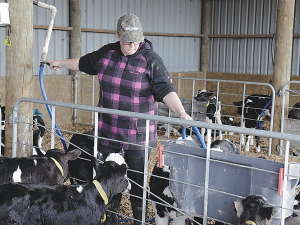Dairy sector profit still on the table, but margin gap tightens
DairyNZ’s latest Econ Tracker update shows most farms will still finish the season in a positive position, although the gap has narrowed compared with early season expectations.
 Cambridge farmer Ashlea Kowalski believes strategies that reduce farmer injuries during the calving season are low cost and easily adopted.
Cambridge farmer Ashlea Kowalski believes strategies that reduce farmer injuries during the calving season are low cost and easily adopted.
Cambridge farmer Ashlea Kowalski believes strategies that reduce farmer injuries during the calving season are low cost and easily adopted.
Kowalski and husband Andy contract milk 245 cows and are using many of the strategies farmers recommended during a DairyNZ study that identified some simple ways farmers can reduce injuries on dairy farms.
“I work full-time and we don’t have any staff, so it’s really important we both stay well to keep the farm running,” says Kowalski.
“By piping milk to calves we can avoid lifting buckets and we’re able to feed 160 calves within 15 minutes. It’s a really efficient way of feeding. Our calf trailer is also a good height for us, and we have trolley jacks on our calfeteria to avoid heavy lifting.”
The couple have the milking area well-lit and keep hoses out of the way when not in use.
“It’s a good idea for farmers to get together with their farm team and assess what the risks are from calving and how to reduce these next season. Many safety strategies farmers can adopt are low cost, are easily adopted and are good for business as well,” she says.
The three-year DairyNZ project, funded in partnership with ACC’s Workplace Injury Prevention programme, is researching the causes of sprains and strains on dairy farms – and developing practical solutions to reduce injuries.
“Around 40% of injuries on dairy farms are sprains and strains, with the highest risk from August to October,” says DairyNZ senior scientist and research lead, Dr Callum Eastwood.
“As calving progresses, fatigue can set in and increase injuries,”
As part of the Reducing Sprains and Strains project, 370 farmers were surveyed on how they managed health and safety, and whether injuries had occurred.
“We know farm teams are working outdoors, in milking sheds, with animals and vehicles. The nature of their work means there is a risk of injury, particularly in busy times. Farmers reported injuries from lifting calves or buckets, from uneven ground and getting off motorbikes. In the milking shed, slippery surfaces and tripping on hoses are hazards,” says Eastwood.
Farmers surveyed used a range of strategies to avoid injury. These included sharing calf collection duties across the team, using a specialist trailer to transport calves, and piping milk into calf feeders rather than using buckets. Other tips included tucking hoses away in the shed and using footwear with a greater grip.
Virginia Burton-Konia, ACC manager - workplace safety, says farmers believe many injuries are avoidable.
“On average, the survey showed people who were injured needed 12 days off work, but took around 27 days to fully recover,” says Burton- Konia.
“With farms often short-staffed, new ideas to avoid injuries and make the job easier will ensure everyone can help out at the busiest time of year.”
The next stage of the project involves developing prototype options farmers can use to reduce injuries.
A calf pick-up trailer designed to reduce back strain is being developed for farmer feedback.
The project is part of work underway through a dairy sector strategy called Great Futures in Dairying to attract, retain and grow the dairy farm workforce over the next decade by developing great jobs, great people and great workplaces.
The National Wild Goat Hunting Competition has removed 33,418 wild goats over the past three years.
New Zealand needs a new healthcare model to address rising rates of obesity in rural communities, with the current system leaving many patients unable to access effective treatment or long-term support, warn GPs.
Southland farmers are being urged to put safety first, following a spike in tip offs about risky handling of wind-damaged trees
Third-generation Ashburton dairy farmers TJ and Mark Stewart are no strangers to adapting and evolving.
When American retail giant Cosco came to audit Open Country Dairy’s new butter plant at the Waharoa site and give the green light to supply their American stores, they allowed themselves a week for the exercise.
Fonterra chair Peter McBride says the divestment of Mainland Group is their last significant asset sale and signals the end of structural changes.
President Donald Trump’s decision to impose tariffs on imports into the US is doing good things for global trade, according…
Seen a giant cheese roll rolling along Southland’s roads?